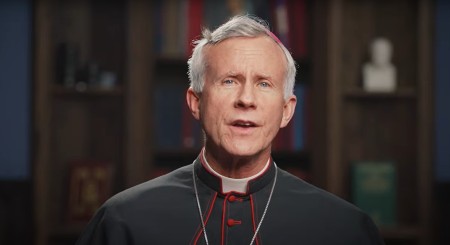 Dear readers, Catholic Online was de-platformed by Shopify for our pro-life beliefs. They shut down our Catholic Online, Catholic Online School, Prayer Candles, and Catholic Online Learning Resources—essential faith tools serving over 1.4 million students and millions of families worldwide. Our founders, now in their 70's, just gave their entire life savings to protect this mission. But fewer than 2% of readers donate. If everyone gave just $5, the cost of a coffee, we could rebuild stronger and keep Catholic education free for all. Stand with us in faith. Thank you. Help Now >
Dear readers, Catholic Online was de-platformed by Shopify for our pro-life beliefs. They shut down our Catholic Online, Catholic Online School, Prayer Candles, and Catholic Online Learning Resources—essential faith tools serving over 1.4 million students and millions of families worldwide. Our founders, now in their 70's, just gave their entire life savings to protect this mission. But fewer than 2% of readers donate. If everyone gave just $5, the cost of a coffee, we could rebuild stronger and keep Catholic education free for all. Stand with us in faith. Thank you. Help Now >
Understanding Catholic Social Teaching: Jesus and the City
FREE Catholic Classes
What does Jesus have to do with the city? Understanding the term city in its broadest sense, that is, as any human community, the answer is everything. "For where two or three are gathered together in my name," Jesus says, "there am I in the midst of them." (Matt. 18:20) "Two or three" is broad enough to include any human community, from marriage on upwards. Jesus is thus at the center of the Church's social doctrine, since he is, or ought to be, in the presence of any relationship between persons.
Highlights
Catholic Online (https://www.catholic.org)
11/2/2011 (1 decade ago)
Published in Living Faith
Keywords: anthropology, community, social, justice, solidarity, community, participation, Social doctrine, Andrew Greenwell
CORPUS CHRISTI, TX (Catholic Online) - What does Jesus have to do with the city? Understanding the term city in its broadest sense, that is, as any human community, the answer is everything. "For where two or three are gathered together in my name," Jesus says, "there am I in the midst of them." (Matt. 18:20) "Two or three" is broad enough to include any human community, from marriage on upwards. Jesus is thus at the center of the Church's social doctrine, since he is, or ought to be, in the presence of any relationship between persons.
What, more precisely, is the "everything" that Jesus has to do with the human community? The Compendium of the Social Doctrine of the Church explores this topic and identifies those various areas where Christ's role is key. The areas relate to the rich offices of Christ, as Son of God and Son of Man, both the Alpha and Omega of everything that is.
In trying to understand this rich doctrine, we might distinguish out the roles of Christ and call them the apocalyptical, the kenotic, the soteriological, the paradigmatic, the transformational, the eleutherian, and the transcendent.
In this article, we will look at the apocalyptical and kenotic aspects of Jesus as they affect the social doctrine of the Church. We will reserve the other aspects for subsequent articles.
The apocalyptical Christ and the apocalypse of man.
The term apocalyptical comes from the Greek term apocalypsis which means "lifting of the veil," or revelation. In this sense, Jesus is the final apocalypse of God. "He who has seen me," Jesus says, "has seen the Father." (John 14:9) There is no veil between God and man in Christ: the veil of the temple that separated man from the Shekinah of God is rent forever. In Jesus one sees the naked God, as it were.
Our response to this great act of benevolence and mercy, of love, ought to be to remove the veils that separate us from Jesus. This is the meaning behind the beautiful formula of St. Jerome so loved by the Franciscans: Nudus nudum Christum sequi. Nakedly we ought to follow the naked Christ. "Jesus' followers are called to live like him," the Compendium says, "and, after his Passover of death and resurrection, to live also in him and by him, thanks to the superabundant gift of the Holy Spirit, the Consoler, who internalizes Christ's own style of life in human hearts." (Compendium, No. 29)
Let us explore this a little more. What does Jesus reveal about God? How are we to be like him, and live in him, and by him? How is this even possible?
Christ, Christians believe, is God incarnate. The ultimate meaning of the Incarnation is the "full revelation of Trinitarian love." (Compendium, No. 30) Most fundamentally, Christ reveals that "God is Trinity: Father, Son, and Holy Spirit; truly distinct and truly one, because God is an infinite communion of love." (Compendium, No. 31) At first blush, one might think that the Trinity has nothing to do with how we should live, but this is not so. It has everything to do with how we should live.
If man was made in God's image, as the first chapter of Genesis has taught us, and God is Trinity, it follows that man is made in the image of the Trinity. In our created nature we find the image of the communion of love between the Father, Son, and Holy Spirit. St. Augustine explores the internal analogies between the mind of man and the Trinity in his book on the Trinity, De Trinitate. But our Trinitarian nature also reflects itself in the relations we have with others.
Drawing on Pope John Paul II's insights, the Compendium summarizes this truth: "'To be human," therefore, "means to be called to interpersonal communion,' because the image and the likeness of the Trinitarian God are the basis of the whole 'human ethos, which reaches its apex in the commandment of love." (Compendium, No. 33) We are designed to be in communion with God and with all men as God is in communion within himself.
In John Paul II's highly-charged words: "Being a person in the image and likeness of God . . . involves existing in a relationship, in relation to the other 'I'". (Compendium, No. 34) This is a high calling, with both relation to the "other 'I'" above us, God, and relation to the "other 'I'" about us, our fellow man. Communion therefore has both vertical and horizontal components. In summary: "The revelation in Christ of the mystery of God as Trinitarian love . . . sheds light on every aspect of the personal dignity and freedom of men and women, and on the depths of their social nature." (Compendium, No. 34)
This Trinitarian aspect of the Catholic social doctrine, of course, is something inaccessible to reason. Accepted by faith, it will, however, open up an entirely new realm of reality to reason. Christ's revelation about the internal life of God "has opened up new horizons [otherwise] closed to human reason by implying that there is a certain parallel between the union existing among the divine Persons and the union of the children of God in truth and love." (Compendium, No. 34) "Christian revelation shines a new light on the identity, the vocation, and the destiny of the human person and the human race." (Compendium, No. 35)
Using Platonic imagery, Christ has taken all mankind out of the cave. We no longer have to look at shadows, but we have access to the realities outside the cave. This is Christ's gift to all mankind.
This means the Church has the key to understanding man that no other philosophy and no other religion has. This is her pearl of great price, her great treasure, her great boon to the world, and it means that the Church has the obligation to share this key and this treasure with every person.
The kenotic Christ and the kenotic man.
Not only does Jesus reveal the Trinitarian life in God and in man, Jesus rendered that inexpressible love concrete in his exemplary passion and in his death, which represented the total giving of his self for others. This takes us to the kenotic message of Christ. Kenotic comes from the Greek word kenosis, which means emptying out. It comes to us from St. Paul's letter to the Philippians: "Jesus emptied himself (ekenosen), taking the form of a servant, being made in the likeness of men." (Phil. 2:7)
By the giving of himself, Christ revealed the hallmark of Trinitarian love. Jesus' commandment--that we "love one another, even as I have loved you" (John 13:34)--means that we have to learn to empty ourselves out, we must extirpate selfishness, so that we may give ourselves more effectively to others. "The commandment of mutual love, which represents the law of life for God's people," the Compendium states, "must inspire, purify, and elevate all human relationships in society and in politics."
The "Politics of Selfishness," as author Paul Nevins in a book by that title called the regime under which we live, are anathema to the Christian who follows an other-regarding kenotic paradigm entirely different from the self-regarding egotistic paradigm advocated by John Locke or Adam Smith or their legion of followers.
-----
Andrew M. Greenwell is an attorney licensed to practice law in Texas, practicing in Corpus Christi, Texas. He is married with three children. He maintains a blog entirely devoted to the natural law, called Lex Christianorum. You can contact Andrew at agreenwell@harris-greenwell.com.
---
'Help Give every Student and Teacher FREE resources for a world-class Moral Catholic Education'
Copyright 2021 - Distributed by Catholic Online
Join the Movement
When you sign up below, you don't just join an email list - you're joining an entire movement for Free world class Catholic education.
-

-
Mysteries of the Rosary
-
St. Faustina Kowalska
-
Litany of the Blessed Virgin Mary
-
Saint of the Day for Wednesday, Oct 4th, 2023
-
Popular Saints
-
St. Francis of Assisi
-
Bible
-
Female / Women Saints
-
7 Morning Prayers you need to get your day started with God
-
Litany of the Blessed Virgin Mary
5 Biblical Warnings We All Must Heed
-

WHAT WILL IT TAKE? | Bishop Strickland Calls Out Silent Bishops in Strong Public Letter
-

Giants of the Fallen: Unveiling the Mystery of the Nephilim from a Catholic Perspective
-
Ancient Wisdom, Modern Choices: How Ecclesiastes 10:2 Illuminates Today's Political Divide
-
How Do We Know Truth? A Catholic Perspective
Daily Catholic
 Daily Readings for Sunday, November 17, 2024
Daily Readings for Sunday, November 17, 2024 St. Elizabeth of Hungary: Saint of the Day for Sunday, November 17, 2024
St. Elizabeth of Hungary: Saint of the Day for Sunday, November 17, 2024 Prayer to Saint Anthony of Padua, Performer of Miracles: Prayer of the Day for Sunday, November 17, 2024
Prayer to Saint Anthony of Padua, Performer of Miracles: Prayer of the Day for Sunday, November 17, 2024- Daily Readings for Saturday, November 16, 2024
- St. Hugh of Lincoln: Saint of the Day for Sunday, November 17, 2024
- Prayer for Life: Prayer of the Day for Saturday, November 16, 2024
![]()
Copyright 2024 Catholic Online. All materials contained on this site, whether written, audible or visual are the exclusive property of Catholic Online and are protected under U.S. and International copyright laws, © Copyright 2024 Catholic Online. Any unauthorized use, without prior written consent of Catholic Online is strictly forbidden and prohibited.
Catholic Online is a Project of Your Catholic Voice Foundation, a Not-for-Profit Corporation. Your Catholic Voice Foundation has been granted a recognition of tax exemption under Section 501(c)(3) of the Internal Revenue Code. Federal Tax Identification Number: 81-0596847. Your gift is tax-deductible as allowed by law.







 Daily Readings for Sunday, November 17, 2024
Daily Readings for Sunday, November 17, 2024 St. Elizabeth of Hungary: Saint of the Day for Sunday, November 17, 2024
St. Elizabeth of Hungary: Saint of the Day for Sunday, November 17, 2024 Prayer to Saint Anthony of Padua, Performer of Miracles: Prayer of the Day for Sunday, November 17, 2024
Prayer to Saint Anthony of Padua, Performer of Miracles: Prayer of the Day for Sunday, November 17, 2024

